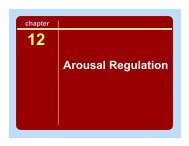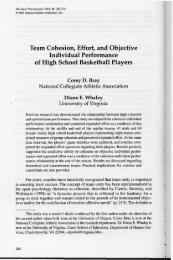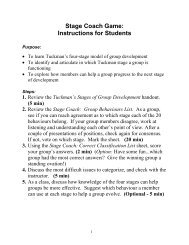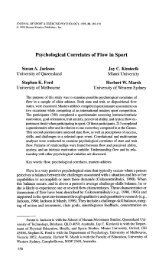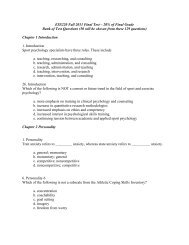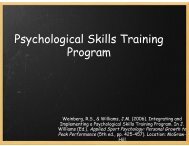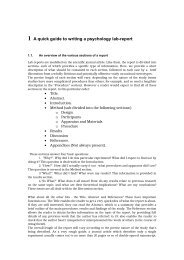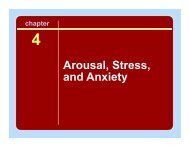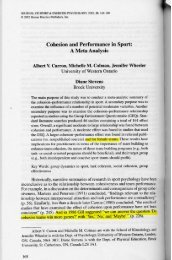Sport and Exercise Psychology Review - Sport Psychology Goes to ...
Sport and Exercise Psychology Review - Sport Psychology Goes to ...
Sport and Exercise Psychology Review - Sport Psychology Goes to ...
Create successful ePaper yourself
Turn your PDF publications into a flip-book with our unique Google optimized e-Paper software.
Mark A. Uphill & Marc V. Jones<br />
formance outcomes (cf. Holder, 2003).<br />
Although the use of pre-shot routines<br />
may reduce the likelihood of errors occurring,<br />
it is inconceivable that mistakes can be<br />
eliminated al<strong>to</strong>gether. Therefore, when<br />
errors do arise, what is required is the capacity<br />
<strong>to</strong> cope with them adaptively. Coping is<br />
often conceptualised as cognitive <strong>and</strong>/or<br />
behavioural efforts <strong>to</strong> deal with internal<br />
<strong>and</strong>/or external dem<strong>and</strong>s appraised as<br />
exceeding the resources of individuals<br />
(Lazarus & Folkman, 1984), <strong>and</strong> may temporally<br />
precede an emotion following an initial<br />
appraisal of harm, threat or challenge, or<br />
flow from an emotion (Lazarus, 1991).<br />
Lazarus suggests that coping efforts can be<br />
classified in<strong>to</strong> one of two categories. Problem-focussed<br />
coping involves taking action<br />
<strong>to</strong> change an aspect of the person-environment<br />
relationship (e.g. distancing oneself<br />
from a stressor). Emotion-focussed coping<br />
on the other h<strong>and</strong>, alters only what is in the<br />
mind of the individual (e.g. re-direction of<br />
attention).<br />
A modest, albeit increasing amount of<br />
literature, has been directed <strong>to</strong>ward coping<br />
with errors in psychology generally (e.g.<br />
Goldberg et al., 2002), <strong>and</strong> more specifically<br />
in sport. For instance, although Holt <strong>and</strong><br />
Hogg (2002) reported that female soccer<br />
players used positive self-talk, problem-solving<br />
talk, <strong>and</strong> imagining past successes <strong>to</strong><br />
cope with errors, the impact of these strategies<br />
on athletes’ emotional state or performance<br />
was not addressed. Theoretically, the<br />
use of emotion-focussed coping strategies<br />
may be advantageous given the lack of control<br />
athletes have over many errors which<br />
have occurred (Uphill & Jones, 2004). Cognitive<br />
<strong>and</strong> behavioural efforts <strong>to</strong> cope with<br />
errors, when used systematically, could be<br />
described as a post-mistake routine (cf.<br />
Moran, 2004). In golf, where competi<strong>to</strong>rs<br />
are typically required <strong>to</strong> perform successive<br />
strokes, possibly after making an error, the<br />
pre-shot routine of the following shot can be<br />
considered an important part of dealing with<br />
any errors that have occurred in a previous<br />
shot. Despite the positive theoretical <strong>and</strong>/or<br />
empirical evidence reported above, there<br />
remains a need <strong>to</strong> underst<strong>and</strong> the impact of<br />
performance routines on the psychological<br />
attributes that may mediate performance<br />
outcomes (Holder, 2003).<br />
Intervention<br />
To alleviate any misconceptions or apprehension<br />
about sport psychology, the participant<br />
was provided with information about<br />
the nature of sport psychology, <strong>and</strong> examples<br />
of skills that would likely be used (e.g.<br />
imagery) prior <strong>to</strong> the intervention. An<br />
emphasis was placed on enhancing pre-existing<br />
psychological attributes, <strong>and</strong> the need <strong>to</strong><br />
practice psychological skills as one would<br />
practice technical skills (cf. Weinberg &<br />
Williams, 2001). With informed consent<br />
attained, the intervention was delivered over<br />
a five-month period <strong>and</strong> comprised five sessions<br />
(each lasting about 60 minutes),<br />
designed <strong>to</strong> review <strong>and</strong> extend the participant’s<br />
pre-shot routine <strong>and</strong> <strong>to</strong> help him cope<br />
constructively with errors.<br />
The intervention commenced with a<br />
review of his existing pre-shot routine. In a<br />
detailed interview, the participant outlined<br />
that his initial routine was predominantly<br />
behavioural. He would (a) st<strong>and</strong> behind the<br />
ball <strong>and</strong> pick a target <strong>to</strong> which he intended<br />
<strong>to</strong> direct the ball; (b) approach the ball <strong>and</strong><br />
align the club head <strong>and</strong> right h<strong>and</strong> behind<br />
the ball; (c) align his body position then redirect<br />
his gaze <strong>to</strong> the target whilst ‘waggling’<br />
his club; <strong>and</strong> finally (d) strike the ball. The<br />
participant remarked that he was a ‘natural’<br />
player <strong>and</strong> did not wish <strong>to</strong> use an elaborate,<br />
regimented routine. At the end of this session<br />
the first author accompanied the participant<br />
on a round of golf <strong>and</strong> digitally<br />
recorded his routine prior <strong>to</strong> every shot on a<br />
nine-hole round of golf.<br />
A second session provided the participant<br />
with the opportunity <strong>to</strong> view his recorded<br />
pre-shot routine <strong>and</strong> describe retrospectively<br />
the purpose of each phase of his existing<br />
pre-shot routine. Appropriate psychological<br />
strategies were introduced. Video observation<br />
of the participant’s pre-shot routine was<br />
16 <strong>Sport</strong> & <strong>Exercise</strong> <strong>Psychology</strong> <strong>Review</strong> Vol 1 No 2



